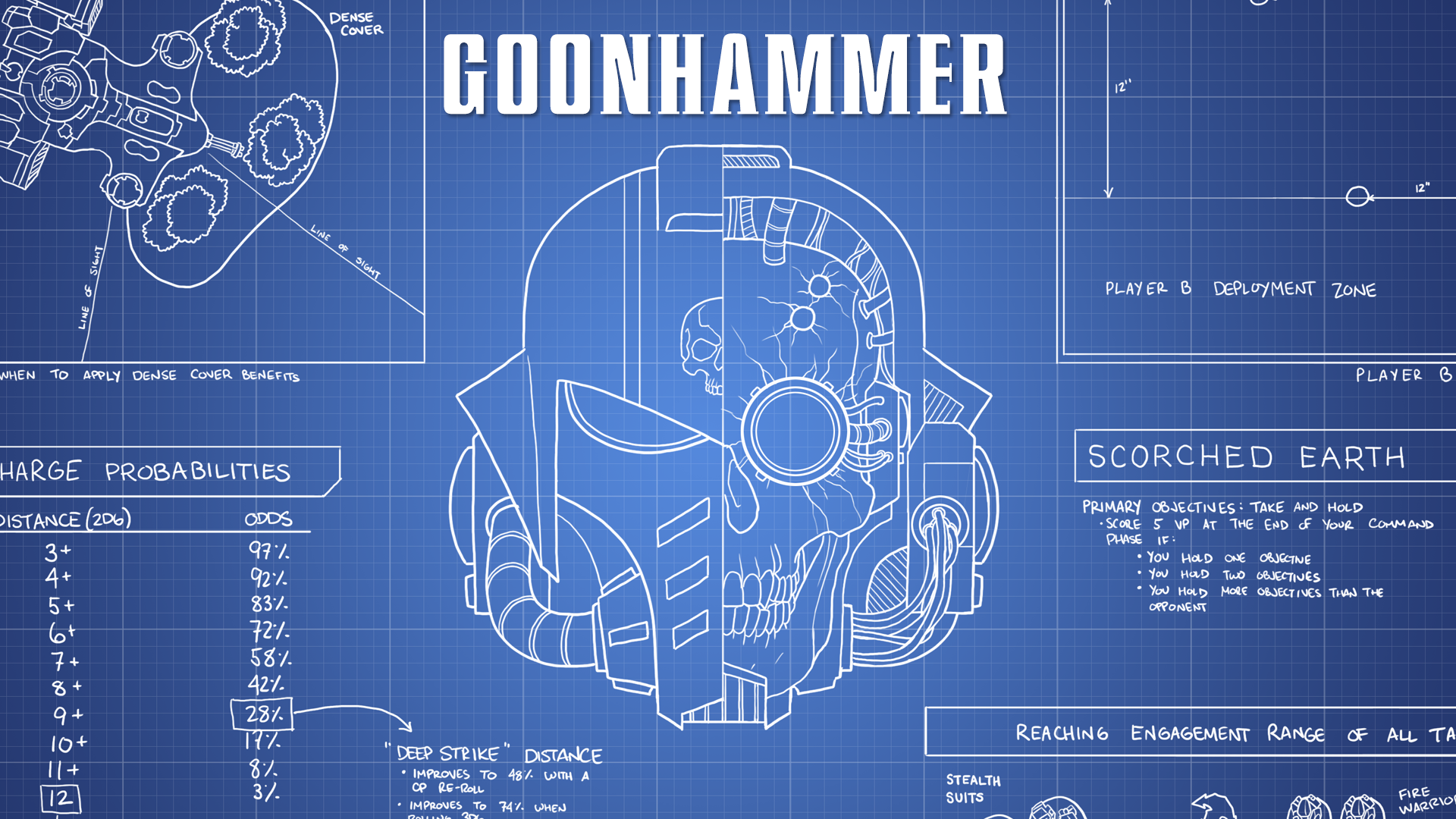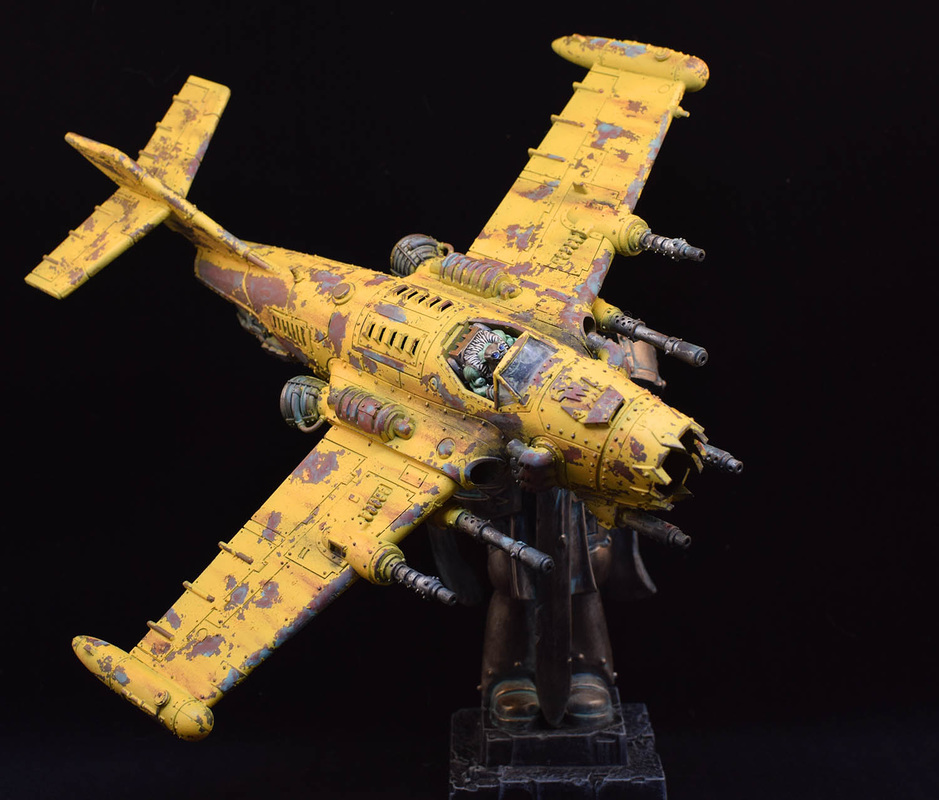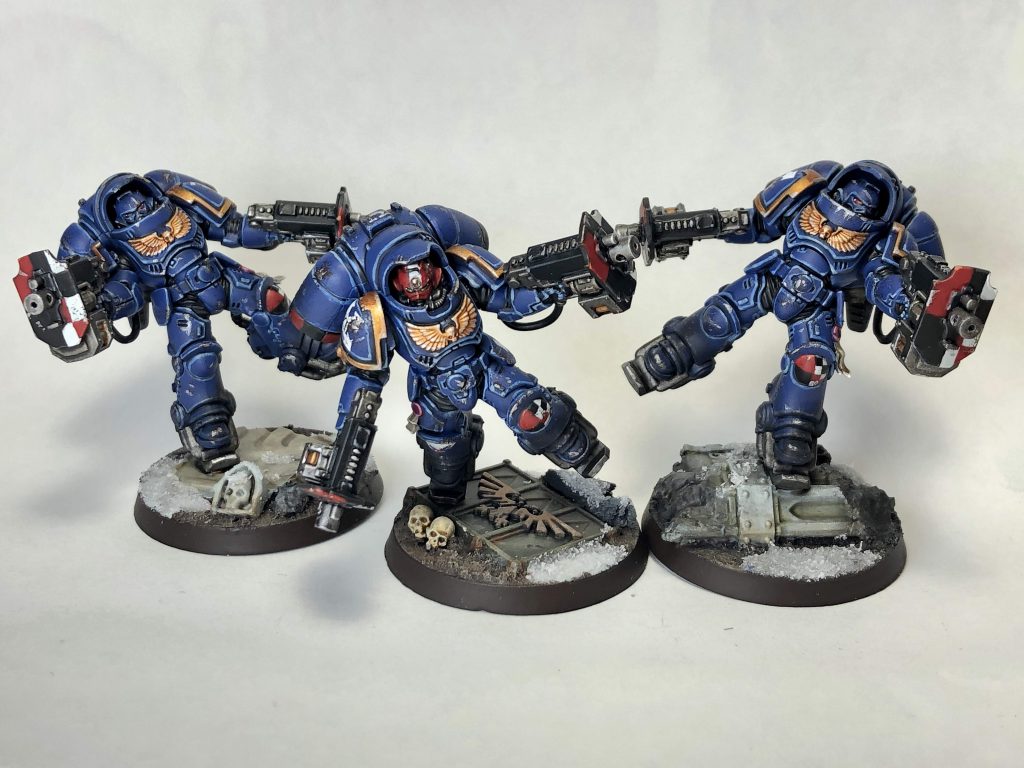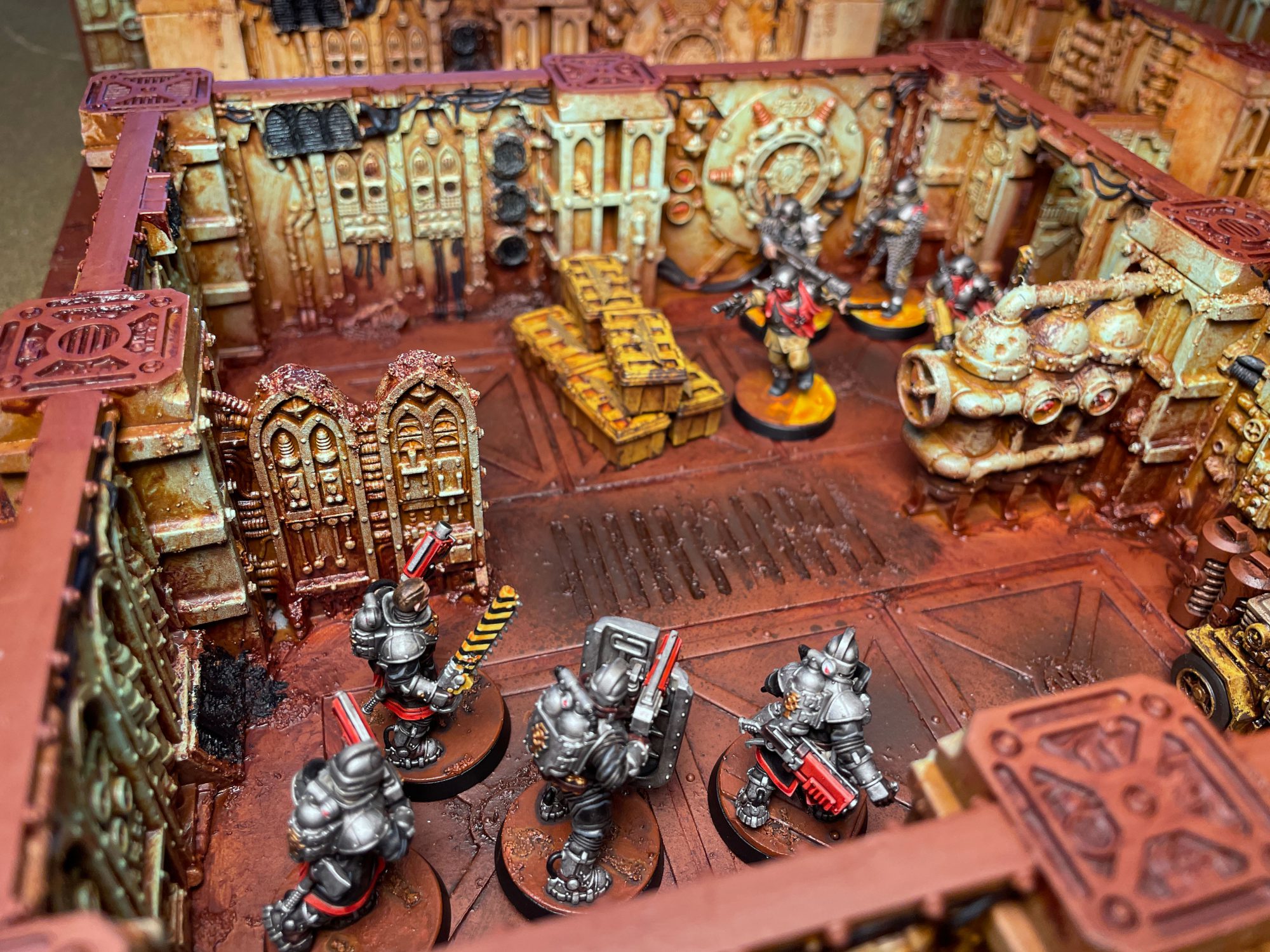Is going to a Rogue Trader Tournament a special occasion for you? Is your competitive list primarily driven by what you have painted? If so, this article is for you! Here we’ll take a look at what the changes in the new Arks of Omen update for Warhammer 40,000 mean for you.
For those unfamiliar with how Games Workshop handles things, every quarter they release an update faction abilities called the Balance Dataslate and every six months they release an updated points list called the Munitorum Field Manual. This is combined with a bi-annual mission pack with new rules; previously this was the War Zone Nephilim: Grant Tournament book. Now we’re on to a new book called Arks of Omen: Grant Tournament. This article covers the effects of all three together. If you’re looking for a very specific, competitive take on these that goes into more detail on the rule changes, you can find that review here.
Okay that’s great, but why should I care?
If you plan on playing in a tournament then this ruleset will be the rules that are used for army construction and missions, meaning that both the way you build your army and the way it plays can be different than how it plays out of the Codex and Rulebook. Even if all you do is play lowkey games with friends in a basement or a local store, this is still a good reference to consider because it contains changes that are intended to make the game more fair and fun at all levels of play. It also provides an opportunity to shake things up and try out new missions. For even more variety you can try implementing Arks of Omen changes into your Tempest of War games, and we provide a guide for that at the end of this article.
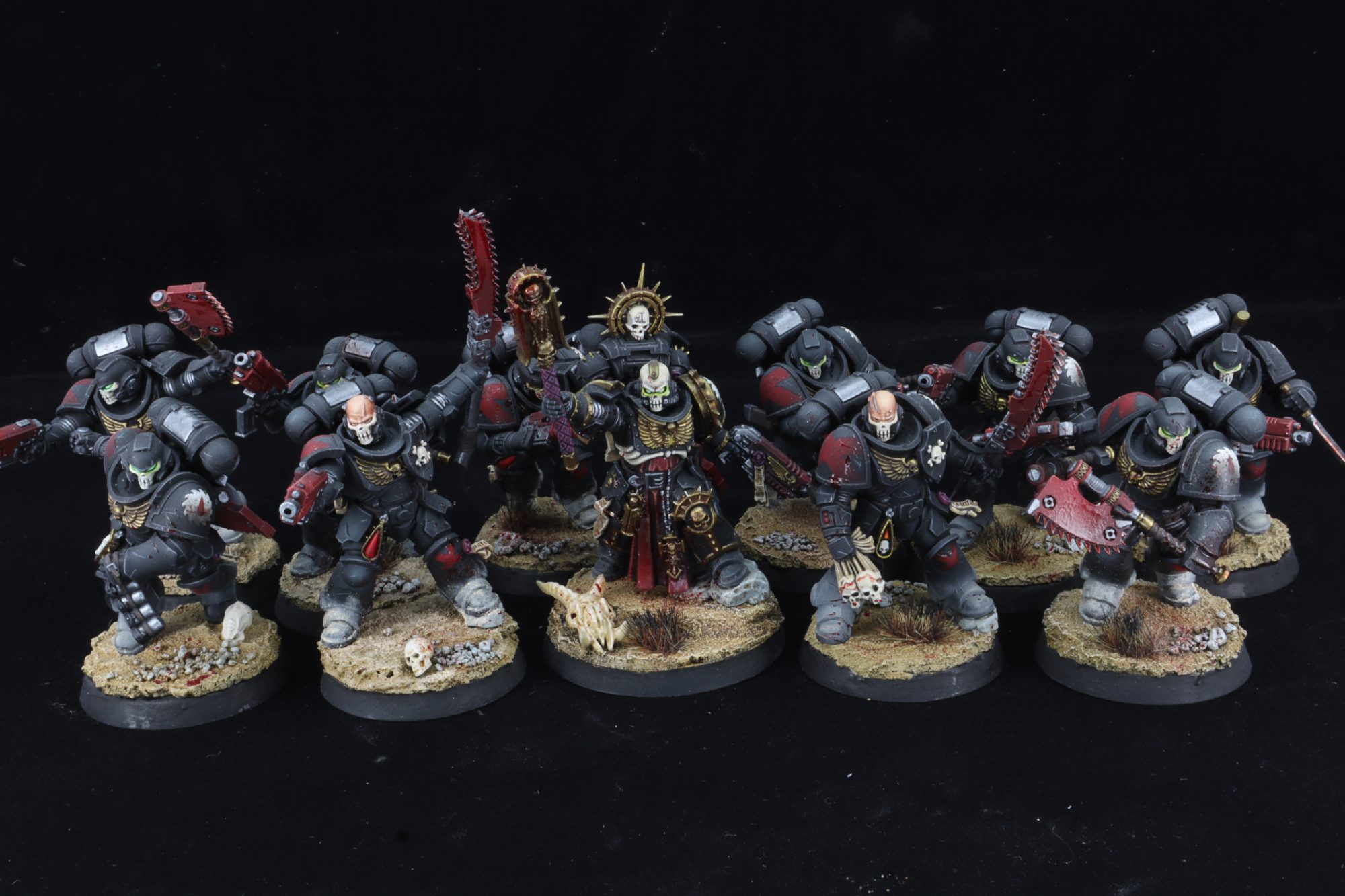
How things have changed
The purpose of this article is to provide a general discussion of how things have changed from the perspective of a player who does not frequently play games and may not have even heard of the previous mission pack. For those interested in a more in-depth analysis of the changes, we highly recommend you read the overview and faction focus articles written by some of the most accomplished competitive 40k players active today.
Your army just got a lot easier to put together and deploy.
The first thing that we need to take a look at is the new Arks of Omen detachment, a massive catch-all force structure which bypasses all of the Patrol, Battalion, Vanguard, Super Heavy, etc. detachment complexity in favor of a single Arks of Omen Detachment. Under the Arks of Omen GT rules every army starts with 6 Command Points, and the detachment does not cost any CP. The only requirement to form the detachment is that you take a single HQ choice (unless you’re a Knights player) and three of the same Battlefield Role. This can be three Elites, three Troops, three Lords of War, anything. Beyond that you can mix and match whatever Battlefield Roles will fit into the chart below, so long as they share a Faction keyword that isn’t IMPERIUM, CHAOS, AELDARI, or TYRANIDS. Note that you can only take a single Arks of Omen detachment, and that the only other detachments permitted are Allied Detachments which are explained later.
This change makes it a lot easier for you to make a viable force using whatever you have at hand without having to pay Command Points to fit it all in. Note that this flexibility isn’t unlimited; unless they’re Troops or Dedicated Transports you’re still restricted to no more than two (in 1000 point games) or three (in 2000 point games) of the same unit. If you have two units that both have a “one per Detachment” limitation then you can pay 1 CP to use the Heroic Support Stratagem to put them in the same Arks of Omen Detachment. You must also pay 1 CP to apply the Warlord Trait and Relic Stratagems, which replaces the free Trait and Relic you got when using the rules in the Rulebook.
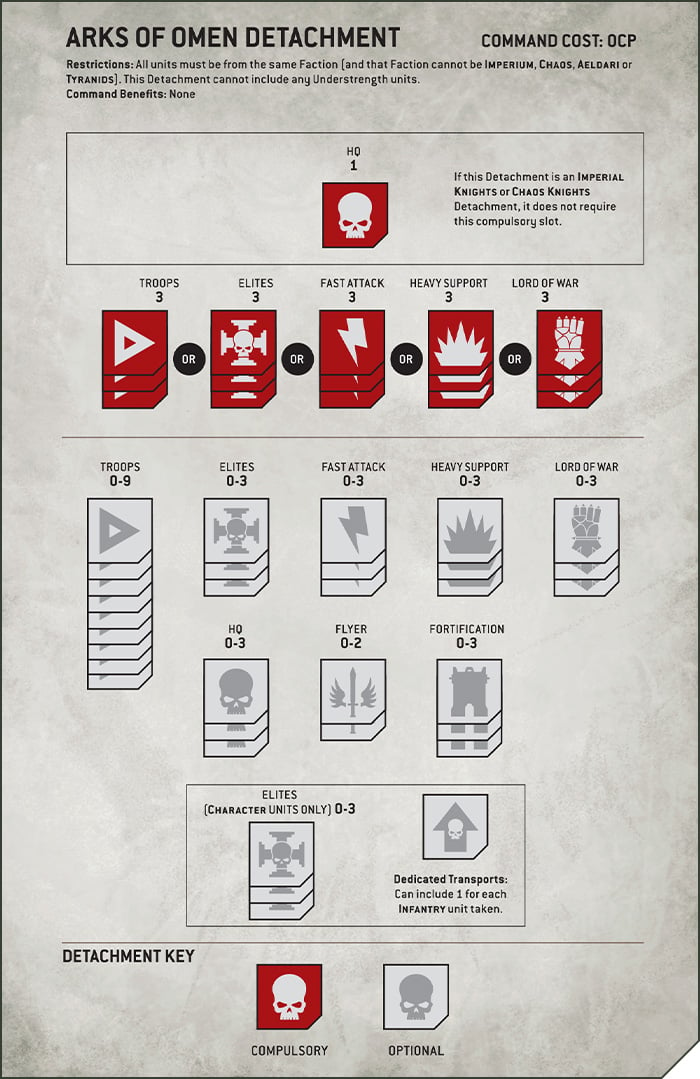
You can use Battle Brothers to add variety.
In addition to the core Arks of Omen detachment, depending on what force you have you can bring one Allied Detachment. Forces with the IMPERIUM faction have a lot of flexibility, and can take either an AGENTS OF THE IMPERIUM Auxiliary or Patrol Detachment, an IMPERIAL KNIGHTS Super-heavy Auxiliary Detachment containing one FREEBLADE unit, or even a VOTANN patrol. Astra Militarum can also add a MILITARUM TEMPESTUS Patrol. Xenos also have some options, as Aeldari (both regular and extra-spiky) can take Harlequins while Genestealer Cults can take a BROOD BROTHERS Patrol, Auxiliary, or even Super-heavy Detachment. For Chaos the various Heretic Astartes legions can take Daemons that are allied to their particular god, every Chaos detachment can take a unit of CHAOS KNIGHTS with the DREADBLADE keyword, and the Disciples of Be’lakor Army of Renow can take both Traitoris Astartes and a Super-heavy Auxiliary Detachment containing one HOUSE KORVAX unit. In other words your force (unless it’s T’au, Orks, or Tyranids) likely has a lot of flavorful options to add some variety.
Some special characters are now less special.
Many players enjoyed using special characters like Abaddon, The Silent King, Shadowsun, and (to a vastly lesser extent) Guilliman in armies that didn’t necessarily use the shared subfaction. With the new Arks of Omen Detachment and Battle Brothers rules you no longer have the ability to bring these special characters in an isolated detachment and so will be forced to use their respective subfaction. In other words if you want to field The Silent King, you’re going to have to play the Szarekhan dynasty.
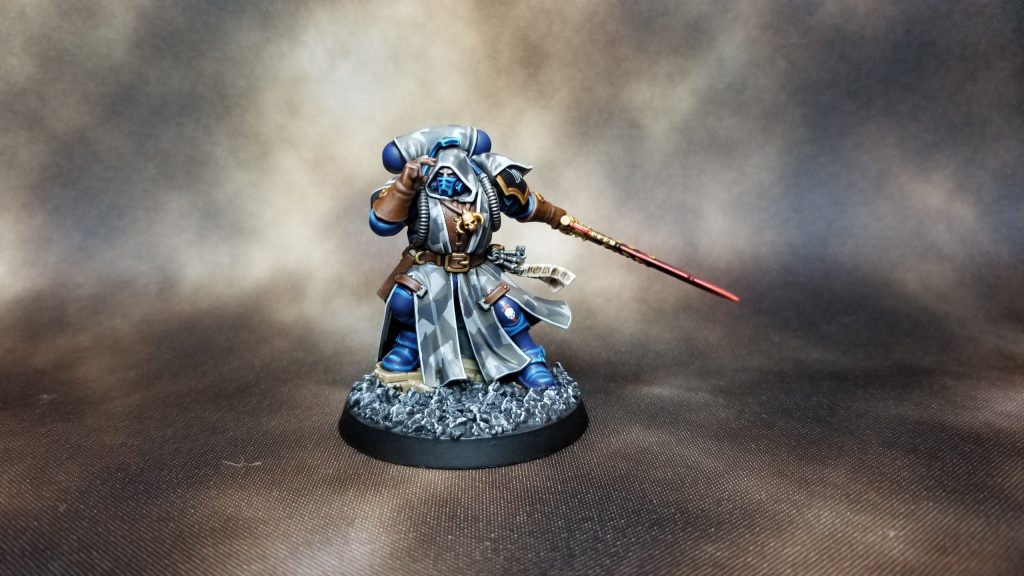
You have a lot more flexibility in your Strategic Reserves.
Arks of Omen includes both a reprint of the Strategic Reserves rules as well as specific instructions for Arks of Omen games. This is important to know because while the Strategic Reserve rules in the back of the book include a CP cost, for Arks of Omen Grand Tournament Games there is no cost to put a unit into Strategic Reserve. This is a big deal because it means you can hide your forces from the enemy if you think you might get wiped out before your first turn, or you have a lot of sneaky abilities. Now you have a lot more opportunities to use them.
You only need one book to play the missions (plus whatever your faction needs).
Matched play can be a complex affair, particularly with respect to things like secondary objectives. Arks of Omen simplifies this by requiring players to only select Secondary Objectives from the book itself. To go along with this a lot of faction-specific secondaries have been adjusted based on feedback and tournament results to make things a bit more fair. The bottom line is that the Arks of Omen book includes almost everything you will need to play, including the core and advanced rules, and everything has been updated to be more balanced. I say “almost” because you also need the four page Balance Dataslate update, the Munitorum Field Manual for the points, any FAQs that GW releases, and of course your Codex.
Planes are different
Bombers were too good, so now they’re a bit worse. Any AIRCRAFT has to now start the game in Strategic Reserves, and any ability that requires the unit to move over a target in the Movement phase (like a bombing run) requires that the unit be on the board both before and after the movement is done. This means it’s very unlikely your forces will be bombed before round 3.
Indirect Fire weapons are less effective when they can’t see what they’re shooting.
This is a change that happened back in April, but if you haven’t played 40k in a bit you might be happy to know that any weapon which can target units that aren’t visible to the bearer now has a penalty when they fire indirectly. If the target is not visible to the shooter then the Ballistic Skill characteristic of the attack is reduced by 1 and the armour save of the target is increased by 1.
Bodyguards can’t hide and still do their jobs.
Another change from April but that you might not be familiar with is that ‘Bodyguard’ abilities have been changed so that the protected CHARACTER unit can use the Look Out, Sir rule even if the protecting unit is fewer than 3 models (which also means you can protect something like a Hive Tyrant). Previously the bodyguard ability was an aura that prevented the protectee from being targeted even if the bodyguard unit was further away and/or out of line of sight. Now they actually have to take the bullet and can’t protect a character who is still the closest unit to the firing model.
 Armour of Contempt is gone.
Armour of Contempt is gone.
Back in April, Games Workshop created an ability called Armour of Contempt which effectively worsened the AP of every attack going against Loyalist Astartes, Heretic Astartes, and Sisters of Battle by 1. This improved the resiliency of these forces quite a bit, but for whatever reason that ability is now gone. This is a major change to a number of forces and if you’re an Orks, Tyranids, Genestealer Cults, Necrons, Drukhari, or Aeldari player you’re now rejoicing at the idea that your AP-1 weapons are suddenly useful again.
Basically every faction was tweaked.
The list of changes is far too great for a summary like this, so we highly recommend taking a plunge into the faction focus articles we’ve put together for you. Major points include that Space Marines are no longer forced to change their Combat Doctrine, Space Marine Troops can maintain control of an objective after they leave, Harlequins all got easier to kill, a bunch of Adeptus Mechanicus got harder to kill, and Tyranids got absolutely screwed. The changes also include significant point reductions for Space Marines (along with making most upgrades free), so if you have a bunch of power armour lying around you might have fun bringing it out again.
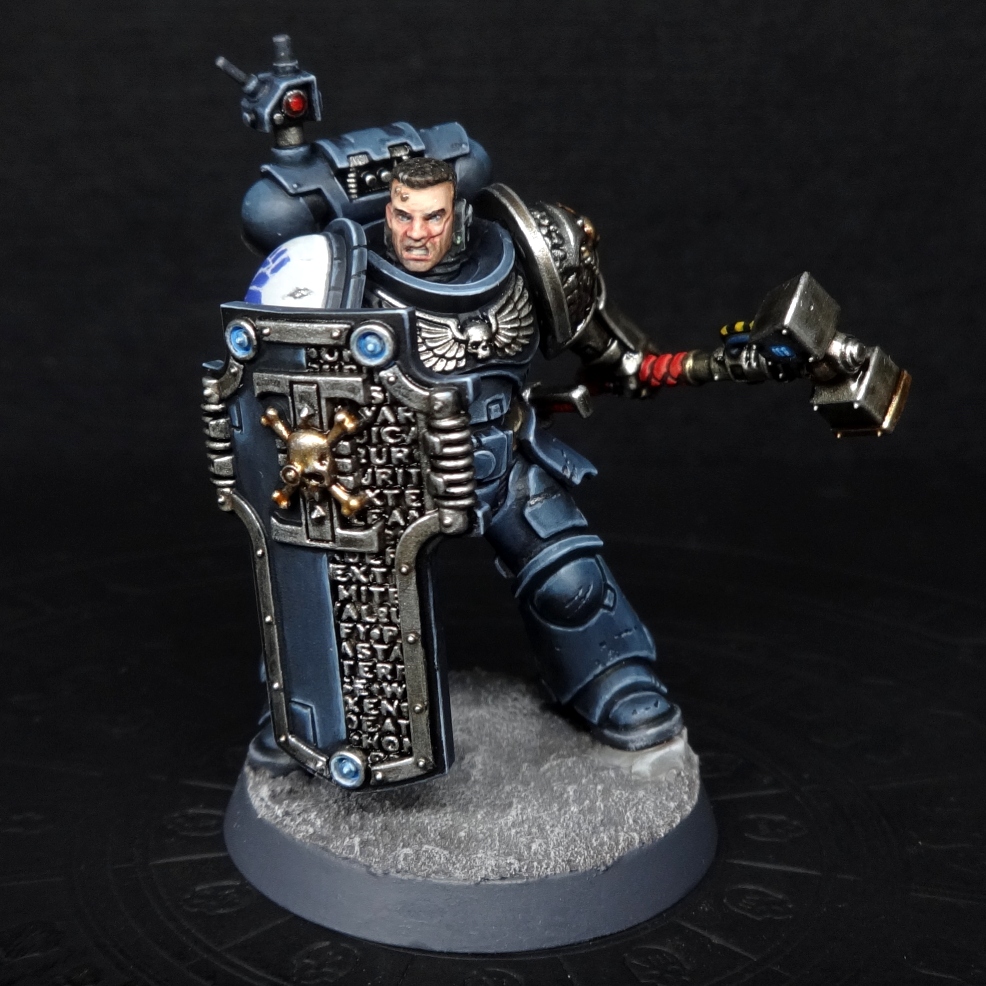
If your opponent starts bringing out a bunch of Terminators or Deathwatch Veterans with storm shields, things might get rough.
While there are way too many changes to cover every faction, one thing you should absolutely be aware of is that Blood Angels, Dark Angels, Deathwatch, and Space Wolves are in a prime position to leverage the fact that most upgrades are now free. While most units like Intercessors might be able to get one or two upgrades, other units have the option to have every model receive a major boost without paying a single extra point. For example Deathwatch Veterans went from 20 points to 27 points, but can get a 15-point upgrade like an infernus heavy bolter or a combi-weapon and storm shield for free. Dark Angels can take Deathwing Terminators at 33 points each (which is the same price as before), but the thunder hammer and storm shield (which was an extra 10 points) is now free along with a cyclone missile launcher (25 points) and a Watcher in the Dark (5 points). We have seen lists that would cost 3000 points in Nephilim now cost 2000 points in an Arks of Omen game.
Using Arks of Omen in Tempest of War
We here at Goonhammer absolutely love Tempest of War and think it’s a great way to play pickup games. Integrating Arks of Omen with Tempest of War is a great way to leverage all of the balance passes that have been made since Tempest of War was developed while still allowing for unpredictable missions. You can merge them together by using the following process.
- Select Battle Size per Arks of Omen (Incursion or Strike Force), starting with 6 Command Points.
- Muster Armies per Arks of Omen, using the Arks of Omen Detachment and the Allied Detachment Rules along with the new Requisition Stratagems.
- Determine the mission via Step 2 of the Tempest of War instructions. Shuffle and randomly draw one card from the Deployment Deck, the Mission Rule deck, and the Primary Mission deck.
- Read the mission briefing off of the selected Primary Mission card, adding the note in the Tempest of War instructions regarding the Secondary Mission Deck. In addition add the following special rule to each of the missions:
Battle-forged CP Bonus: In this mission, at the start of each player’s Command phase, both players gain 1CP, not just the player whose turn it is. These CP are Battle-forged CP bonuses, and so the limit of gaining a maximum of 1CP per turn does not apply to CP gained as a result of this rule. - Determine Attacker and Defender by rolling off. The winner decides who is the Attacker and who is the Defender.
- Place objective markers per the Tempest of War instructions, alternating the 4 (Incursion battle) or 5 (Strike Force battle), starting with the Attacker.
- Choose the deployment zone by having the Defender select which one they want for their army.
- Perform the remaining steps per Arks of Omen, starting with step 10 (Declare Reserves and Transports).
What about that thing where you fight on a ship?
Amusingly enough Games Workshop has not only released Arks of Omen: Grand Tournament Mission Pack, but they’re also going to release a series of rules called Arks of Omen focusing on boarding gameplay. The first one is called Arks of Omen: Abaddon and contains the basic rules for playing. We’ll have more on this when we publish our review of the upcoming book.
So what’s next?
We highly recommend checking out the Arks of Omen GT content, as it does a very good job of consolidating rules and providing a decent balance pass. If you intend to play in any kind of tournament setting (and you should, they’re a lot of fun) then you’ll need to be familiar with the rules anyway. Outside of tournament play the Arks of Omen rules are still a solid foundation for pick-up games, especially if you combine them with a Tempest of War deck using the suggested approach above. Either way the best game of 40k is the one you’re currently playing, so roll some dice and have fun!
If you have any questions or comments feel free to drop us a note in the Comments below or email us at contact@goonhammer.com. That’s also the best way to suggest topics for future articles.
